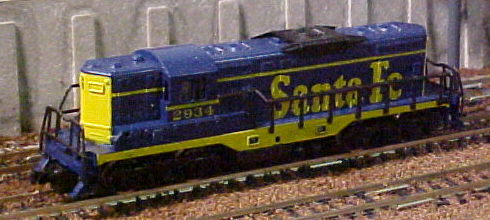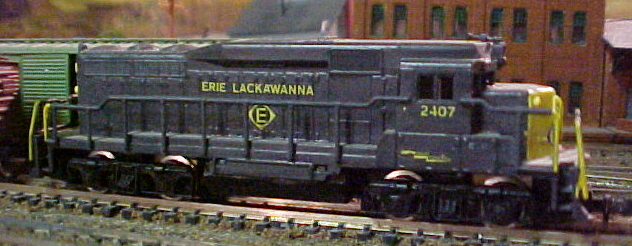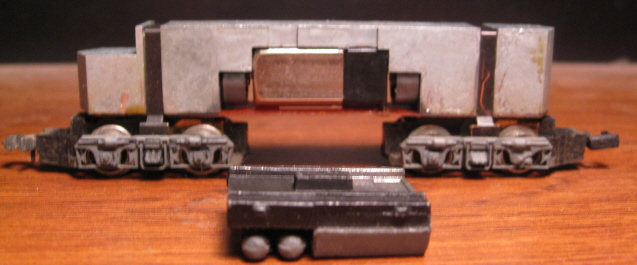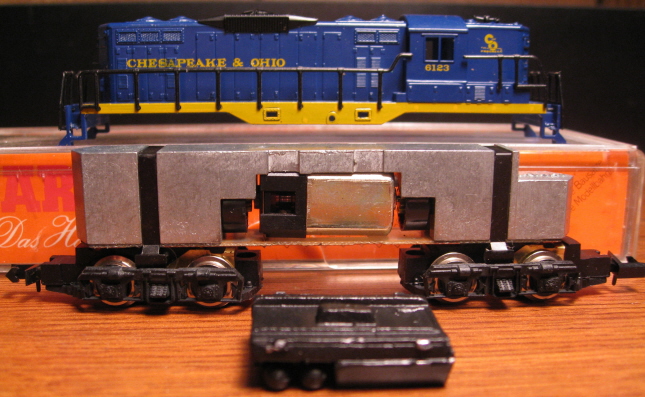





Introduced: 1969 (revised 1986)
These Arnold geeps all came out at about the same time and all share the same basic chassis/mechanism. So, to save a bit of time I'm going to review them all here.
The GP30 was the first of the trio to emerge, followed by the GP7 and GP9 models a few months later. The GP7/9 dual release was basically Arnold trying to get two models for the price of one. The only difference between the two is that their "GP9" model has a dynamic brake blister on the roof and their "GP7" doesn't. Unfortunately, in the real world when you take a GP7 and add dynamic brakes to it, you get a GP7 with dynamic brakes and not a GP9. Yeesh.
These models were originally imported into the US by Revell (a relationship that would last up until around 1972). After that they had various importers and distributors (Walthers, most notably). Amazingly, these models were available for decades. Arnold was eventually acquired by Rivarossi in the 1990s, and these models all ultimately vanished after Rivarossi's bankruptcy/liquidation circa 2005. The old Revell imports came in cardboard "Revell-Rapido" boxes. Post-Revell, these came packaged in the familiar Arnold plastic box with the orange paper insert.
Overall, these are fairly mediocre models (even by 1969 standards). The shells are pretty ugly, the paint and detailing are fairly unimpressive, and the performance is, well... it is what it is. All wheels are geared and provide pickup, and the mechanism is mostly metal, fairly heavy, and blessedly free of wiring. No traction tires, so with 8 wheels on the rails pickup isn't too bad.
That's the good news. The bad news is that the motor is fairly primitive, and although the top-end speed is surprisingly reasonable, slow speed performance is very unimpressive. And wow, let's talk about that primitive "cup gear" reduction on the driveshafts (not to mention all of that brass gearing). Suffice it to say, there might have been louder N scale locomotives somewhere along the line, but I sure can't think of them. None of these have any sort of lighting. All of them have truck-mounted Rapido couplers, open pilots, and oversized flanges that turn any switch into a hazard (and forget about running these on anything like Code-55 track).
So, for their day I guess these were adequate enough locos. Back in the late 1960s, just getting something that would run reliably and pull a decent sized train was a rarity. Consequently, many old-time N-scalers look back fondly on these models. Of course, they're completely dated by today's standards (the models, not the old-time N-scalers).
There have been two basic versions of this mechanism (the updated version coming out in 1986). And as noted in the MR article below, the changes were head-scratchingly minor. The updated version has a slightly different motor, the trucks have an additional screw on the bottom (two per truck instead of one), and the stamping on the bottom of the fuel tank changed. Also, it looks like they might have used a different kind of plastic in some of the internal chassis gearing. And really, that's about it.
To get at the guts, remove the fuel tank piece by prying open the shell to free the four clips. Once removed, the shell just slides off. Annoyingly, these do not run unless they are completely assembled (the mechanism apparantly needing the fuel tank and shell to hold things together).

Second version

Any actual difference in performance between the two versions is pretty difficult to measure (particularly when dealing with decades-old models). Just based on the few examples I've been able to acquire and test-run, I'd say the updated version might be slightly better in the slow speed department, whereas the original version might actually run a bit quieter. But honestly, the differences are almost negligable, and certainly not enough to recommend one version over the other.
Grade: C (all versions)
GP30 reviewed 2/69 Model Railroader ("The ready-to-run model follows the proportions of the prototype generally, but does depart in some dimensions. The model has oversize 48" wheels which, when coupled with their .037"-deep flanges, make the wheels appear considerably larger then the prototypes 40" wheels. Because of this the engines rests a scale 9" to 12" too high... An examination of the trucks revealed that the shape is easily recognized as EMD style, but has the commonly found shaping fault... In spite of these... has a good appearance... Neither the excessive height nor the incorrect truck sideframe is noticeable in normal viewing... A 12-volt DC motor drives both trucks through a combination spur-gear and worm-gear drive... A zinc allow frame which contains the motor and gear drive slips up into the body cavity, filling it completely... Wipers on the trucks contact a circuit board, using all eight wheels for electrical pickup... The mechanism runs smoothly and quietly... Smooth-starting speed is good... The minimum speed, running light, is 9 to 10 scale MPH... The model runs well and will double-head with most other N-scale diesels... Available in Soo and Northern Pacific... Price $12.98")
GP7/9 reviewed 9/69 Model Railroader ("Rapido has what is called both GP7 and GP9 models, but they are essentially GP7 bodies in both cases. Rapido's GP9 has dynamic brake hatches, to distinguish it; however, in prototype both models were available with dynamic brakes. The ready-to-run GP9 is reasonably accurately scaled and proportioned, although some liberties have been taken to accommodate the Rapido mechanism which sports wheels a scale 45" in diameter. The prototype has 40" wheels. With this and the .037"-deep flanges, the body is necessarily raised 9" to 12"... The body is a one-piece, well-detailed plastic molding. The ends have been cut away to clear the Rapido-type automatic couplers... The drive is identical to the one use in the (Arnold-Rapido) GP30 model, featuring 8'-6" wheel-base trucks, eight-wheel drive, and as 12 volt DC motor... Like previous models using this drive, our test sample started smoothly. The slowest speed is a little high. With a load it is better and good starts are possible. The engine is a fine-running model. The GP9 ($13.98) is available in Santa Fe or Penn Central. The GP7 ($12.98) is available in Erie Lackawanna or Southern Pacific")
Revised GP7/9 reviewed 10/86 Model Railroader ("In studying Arnold's GP9, advertised as "new", I was a bit surprised to find it was nearly the same as the original unit, sold under the Rapido name, that we reviewed back in 1969. The present model has the original injection molded plastic body, handrails, and sideframes. Except for the motor itself, even the mechanism seems to be the same... The only change is the paint schemes. The mechanism looks just like the one in the old Rapido unit. Nearly all of the interior space within the body is filled by a cast zinc-alloy weight. This weight has cavities in it to accommodate the new motor, and the universals and gears. The motor has a spur gear on each end that turns against the inside of a cup gear on the worm shaft. Each truck has a large gear that engages the worm and turns the axle gears as well. A printed circuit board, attached to the bottom of the weight, carries the electrical circuitry between the motor and the trucks. Both trucks are divided electrically, and tiny wipers on the backs of the wheels pick up from all 8 wheels. The wheelsets are somewhat oversize and have deep flanges. The relatively high starting speed seems to be a continuing characteristic of these units... The Arnold GP9 is a reliable unit. However, I am a bit disappointed as I expected this "new" unit to be improved at least a little over those of 17 years ago. While the model runs smoothly at intermediate speeds, its lack of slow speed performance is a major handicap. In this area, it is simply outclassed by its newer competitors. PRR, SP, BN, SF, Conrail. $57.98")